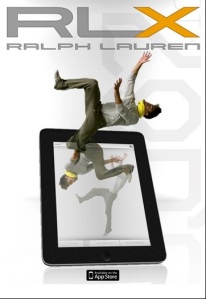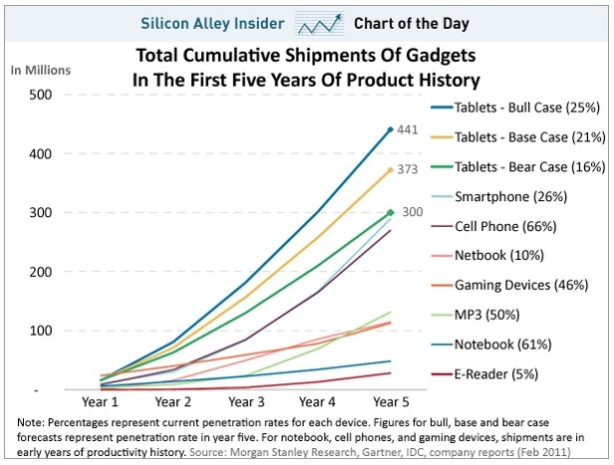Of all the industries to learn that every company has to become a media company, the fashion industry wouldn’t instinctively leap out as an early adapter. It has been built on telling the consumer what to wear and perpetuating the “art” of design. Anyone who has looked at what clothing designs will become “hot” in the new season can see that they will never fit in those designs unless they skip eating for three month and work out at their local gym daily.
But, in fact, the fashion industry has embraced digital media and is basking in its new, more direct, “relationship” with its customers. It is using digital media to tell a much more interesting story about what it is offering, to take an enhanced version of its traditional “runway” presentation directly to the public, to all their customers to experiment with and customize their products and to learn what their customers are buying and aren’t buying, and why.
 Gucci began selling out of it’s own online store nine years ago, but has since make itself a presence on every possible platform, from social networks to apps. In recent years it has devoted microsites to product lines from eye wear to watches. It uses these various touch points to engage their customers in more than just buying.
Gucci began selling out of it’s own online store nine years ago, but has since make itself a presence on every possible platform, from social networks to apps. In recent years it has devoted microsites to product lines from eye wear to watches. It uses these various touch points to engage their customers in more than just buying.
Gucci began live streaming of its spring 2011 runway show. To give online viewers the full taste of the event, they were told to sign up for virtual tickets for the online even and compete for “VIP” seating through a contest on Facebook. You can even recreate the rejection of not getting great seats!
 Users were encourage to upload photos of themselves wearing Gucci glasses on one site and create personalized videos on Facebook using clips of various eye wear models. More than 5,500 videos have been created on the Facebook page, which has more than 3 million friends.
Users were encourage to upload photos of themselves wearing Gucci glasses on one site and create personalized videos on Facebook using clips of various eye wear models. More than 5,500 videos have been created on the Facebook page, which has more than 3 million friends.
But it’s not all fun and games. It’s sales. Gucci President and CEO Patrizio di Marco told Womens Wear Daily that the newly updated Gucci.com, which draws about 3 million visits a month, “willl become our highest volume store in the world”
 Ralph Lauren has been another pioneer into digital media from the fashion world. From the early stages, Polo has been an aggressive player on several fronts, creating multiple sites and apps around specific products and audiences. It’s latest is its first RLX app, which features athletes wearing the RLX line and gives the user a unique understanding of what the clothing is designed to do. The free IPad app uses the device’s compass, GPS and touch screen to help the user play with the “experience” of using the clothes. “This application places the user in the driver’s seat so that they can control the technical functions of the apparel and experience the brand in a way that is visually entertaining,” Polo executive David Lauren told WWD.
Ralph Lauren has been another pioneer into digital media from the fashion world. From the early stages, Polo has been an aggressive player on several fronts, creating multiple sites and apps around specific products and audiences. It’s latest is its first RLX app, which features athletes wearing the RLX line and gives the user a unique understanding of what the clothing is designed to do. The free IPad app uses the device’s compass, GPS and touch screen to help the user play with the “experience” of using the clothes. “This application places the user in the driver’s seat so that they can control the technical functions of the apparel and experience the brand in a way that is visually entertaining,” Polo executive David Lauren told WWD.
Another particularly interesting, and interactive, player has been Cinique’s new IPad Skin Diagnostic Tool for the sales counter, which allows a user to test for foundation and color cosmetics while seeing product information and user reviews of the products. It answers questions individuals skin and produces a personal analysis from consumers, including product recommendations. The device has resulted in an average sales jump of 30% wherever it is installed.
 The company is also using its presence in Bloomingdales in NYC to test its new “Smart Bar”, which uses Microsoft’s Surface technology and a new large touch screen embedded in a counter top to identify a product when it is waved overhead and bring up information about that product on the screen. And, Clinique has also created a virtual makeup mirror on its website that allows the user to download a picture of their face, and simulate a product demonstration on that picture. According to Clinique, 50 percent of in-store purchases are influenced by online information.
The company is also using its presence in Bloomingdales in NYC to test its new “Smart Bar”, which uses Microsoft’s Surface technology and a new large touch screen embedded in a counter top to identify a product when it is waved overhead and bring up information about that product on the screen. And, Clinique has also created a virtual makeup mirror on its website that allows the user to download a picture of their face, and simulate a product demonstration on that picture. According to Clinique, 50 percent of in-store purchases are influenced by online information.
Perhaps the most interesting technology development in the fashion business comes from Google, who probably employs the least fashionable workforce in the world. Google build Boutiques.com, which tracks consumers shopping behavior. Besides attracting tens of millions of users to hundreds of thousands of online boutiques that have been set up on the site.
What Google has done for the industry is set up a digital listening post. By providing “Designer Analytics,” Google gives the boutique owners a deep dive into the habits of shoppers, telling them not just what they are buying, but why. They are given information about what specific products are “loved” or “hated”, what colors, shapes and patterns are resonating or not. Then there is a totally different, and broader, data set on the consumer trends. Here the designers learn what is happening in the aggregate to all designers, not just themselves. So industry trends in color, shapes and patterns can emerge from the general public.
Besides helping the designers find their audience, Boutiques.com is also designed to help the shopper find what he or she is looking for.
Google describes the service on the site this way:
“Boutiques.com is a personalized shopping experience, brought to you by Google, that lets you find and discover fashion goods through a collection of boutiques curated by taste-makers — celebrities, stylists, designers, and fashion bloggers. Boutiques uses visual technology to help fashionistas discover and shop their look and creates the opportunity for designers to showcase their collections and latest inspirations online.
 “Boutiques.com is built on technology developed by our team of fashion experts who work with engineers to “teach” our computer systems to understand various patterns, pairings, and genre definitions. When signed into your account, Boutiques.com learns about your style and preferences and in turn, provides you better results and recommendations over time. Ultimately, Boutiques.com will provide shoppers with a much richer and interactive shopping experience and help drive traffic to retailers’ websites.”
“Boutiques.com is built on technology developed by our team of fashion experts who work with engineers to “teach” our computer systems to understand various patterns, pairings, and genre definitions. When signed into your account, Boutiques.com learns about your style and preferences and in turn, provides you better results and recommendations over time. Ultimately, Boutiques.com will provide shoppers with a much richer and interactive shopping experience and help drive traffic to retailers’ websites.”
This is a brilliant move on Google’s part to improve the experience of both sellers and buyers in a specific marketplace — fashion — and in doing so create a spot for itself, Google, to build a business as an enabler.
In all of the examples above, technological advances are enabling companies in an industry – in this case fashion — to behave more like media companies in how they communicate their message and interact with their customers. They learn to use communication skills directly instead of indirectly through media and advertising.
In the end, it can improve upon and to some extent, ultimately displace the existing marketplace and its infrastructure, including retailers and traditional marketing outlets and media. It allows the Internet to do what it does best: match buyers and sellers and squeeze middlemen.


















